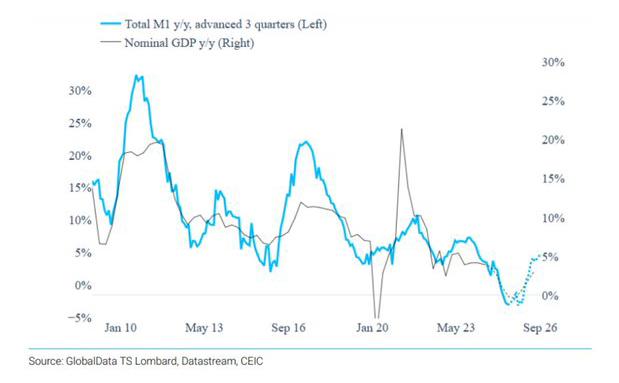China’s economy is facing a perilous spiral that threatens to undermine its long-term stability and global standing. As growth slows and debt mounts, policymakers find themselves caught in a self-reinforcing cycle of economic stagnation and mounting financial risks-a “doom loop” from which escape appears increasingly difficult. This article explores the underlying factors fueling China’s downward spiral, the implications for national security, and the challenges Beijing faces in steering the world’s second-largest economy back onto a sustainable path.
China’s Debt Crisis Undermines Growth Prospects and Global Stability
China’s staggering debt levels have become a critical constraint on economic expansion, pushing the nation into a perilous cycle of slowed growth and escalating financial vulnerabilities. Local governments and state-owned enterprises, burdened by opaque off-balance-sheet liabilities, continue to rely heavily on borrowing, exacerbating the risk of defaults that could ripple throughout the global financial system. This unsustainable debt accumulation not only dampens domestic consumption and investment but also increases market uncertainty, limiting Beijing’s maneuverability to implement effective stimulus without triggering inflation or currency instability.
Key factors intensifying this crisis include:
- Rapid expansion of shadow banking and hidden debt instruments
- Weakening property sector suffering from plummeting asset values
- Slower export growth amid mounting geopolitical tensions
- Strained credit conditions constraining private enterprise financing
| Debt Category | Estimated Size (Trillions USD) | Impact on Economy |
|---|---|---|
| Local Government Financing Vehicles (LGFVs) | 3.5 | Housing, infrastructure bubbles |
| Corporate Debt | 13.5 | Investment slowdown, layoffs |
| Household Debt | 7.0 | Reduced consumer spending |
State Intervention Stifles Innovation and Market Confidence in Key Sectors
The Chinese government’s heavy-handed involvement in strategic industries continues to undermine the very foundations of market dynamism. By prioritizing state-led development and extensive regulatory oversight, innovation ecosystems are increasingly suffocated. Private enterprises, often the primary drivers of breakthrough technologies and disruptive business models, face growing uncertainty as policies fluctuate unpredictably, limiting investments and discouraging entrepreneurial risk-taking. This persistent climate of intervention triggers a chilling effect on venture capital flows and stifles competitive market forces essential for sustained technological progress.
Key sectors, including technology, finance, and energy, exhibit clear signs of stagnation under this model. The following table illustrates the recent trends in innovation indices and investment confidence across these industries:
| Sector | Innovation Index Change (2020-2023) | Investment Confidence (%) |
|---|---|---|
| Technology | -15% | 42% |
| Finance | -10% | 38% |
| Energy | -12% | 45% |
These figures reflect not only drops in innovation output but also a growing skepticism among domestic and international investors regarding China’s long-term economic potential. Market confidence is further eroded by opaque decision-making and arbitrary enforcement of regulations. Amid these pressures, many promising ventures either relocate operations abroad or curtail expansion plans. Without fundamental reforms to reduce state control, China risks entrenching a vicious cycle where lack of trust feeds reduced innovation, ultimately imperiling its global competitiveness.
- Overregulated markets hinder startup formation and scaling.
- State monopolies crowd out private innovation initiatives.
- Investment volatility discourages long-term strategic projects.
- Policy uncertainty breeds hesitation among investors and entrepreneurs.
Strategic Policy Shifts Urgently Needed to Break the Economic Vicious Cycle
China’s economic malaise is not just a temporary setback-it reflects deep structural issues demanding bold, forward-thinking policy transformations. Policymakers must pivot from short-term stimulus to sustainable reforms that address the root causes of stagnation. This includes recalibrating fiscal priorities towards innovation-driven growth, enhancing transparency in governance, and dismantling the inefficient state-owned enterprise dominance that stifles private sector dynamism. Without a clear strategy to realign economic incentives, the cycle of debt accumulation, sluggish consumption, and subdued investment will only intensify, leaving the country vulnerable to external shocks.
Effective intervention requires a multipronged approach, combining monetary prudence with targeted social policies. Key areas of focus should be:
- Financial sector reform: Strengthen regulatory frameworks to prevent asset bubbles and risky lending practices.
- Labor market flexibility: Promote skill development and mobility to adapt to evolving industries.
- Environmental sustainability: Integrate green initiatives to future-proof growth against global climate mandates.
| Policy Focus | Current Challenge | Recommended Shift |
|---|---|---|
| Debt Management | Unsustainable borrowing levels | Prioritize debt restructuring and transparency |
| Consumption Boost | Weak domestic demand | Incentivize middle-class spending |
| Innovation Support | Limited R&D investment | Increase funding for tech startups |
To Conclude
As China’s economy remains ensnared in a complex cycle of stagnation and structural challenges, the path to sustainable growth grows increasingly uncertain. Policymakers face mounting pressure to enact reforms that can break the downward spiral before long-term damage undermines not only the nation’s economic prospects but also its geopolitical standing. In a rapidly shifting global landscape, the stakes for China-and the world-have never been higher.




